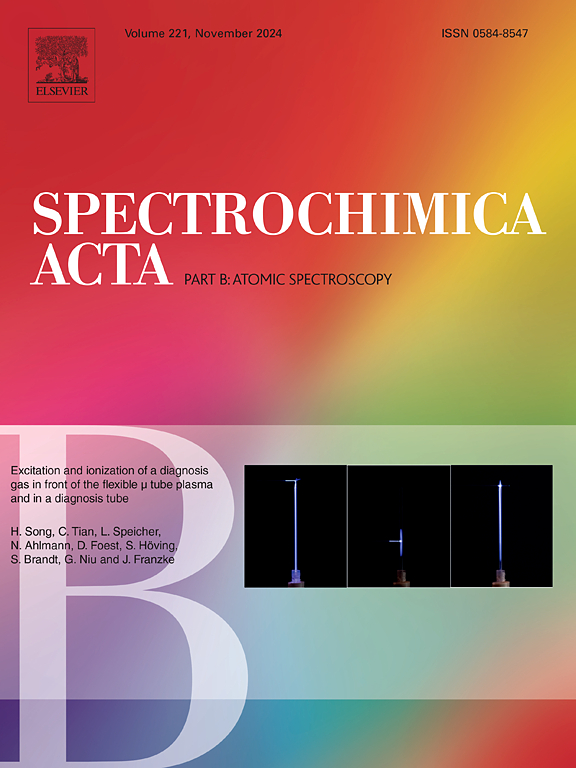Quantitative analysis of soda-lime glass by the LIBS technique based on the TEA CO2 laser
IF 3.2
2区 化学
Q1 SPECTROSCOPY
引用次数: 0
Abstract
The present work studies the capability of a Laser-Induced Breakdown Spectroscopy (LIBS) system based on a Transversely Excited Atmospheric pressure (TEA) CO2 laser for quantitative analysis of soda-lime glass. Calibration curves of Cd, Co, Cr and Cu were constructed using the ratio of the analyte emission line intensity to the line intensity of the internal standard. Coefficients of determination were in the range from 0.969 to 0.983, depending on the element. The accuracy of LIBS results was confirmed by X-ray spectrometry (XRF). Limits of detection (LODs) for several elements (Cd, Co, Cr, Cu, Fe, Ti and Ca) were estimated (typical values in range of 13‐24 ppm were obtained). The Stark-broadening and two ionic lines intensity ratio were used to determine electron number density and excitation temperature. Profilometric measurements showed the low destructiveness typical for LIBS technique, without glass damage such as shattering and cracking.

基于TEA CO2激光的LIBS技术对钠钙玻璃进行定量分析
本文研究了基于横向激发大气压(TEA) CO2激光器的激光诱导击穿光谱(LIBS)系统对钠钙玻璃进行定量分析的能力。利用分析物发射谱线强度与内标谱线强度之比构建了Cd、Co、Cr和Cu的校准曲线。测定系数R2范围为0.969 ~ 0.983。用x射线光谱法(XRF)验证了LIBS结果的准确性。对几种元素(Cd, Co, Cr, Cu, Fe, Ti和Ca)的检出限(lod)进行了估计(获得了13 - 24 ppm范围内的典型值)。利用stark -展宽和两离子线强度比测定了电子数密度和激发温度。轮廓测量表明,LIBS技术的典型破坏性较低,没有破碎和开裂等玻璃损伤。
本文章由计算机程序翻译,如有差异,请以英文原文为准。
求助全文
约1分钟内获得全文
求助全文
来源期刊
CiteScore
6.10
自引率
12.10%
发文量
173
审稿时长
81 days
期刊介绍:
Spectrochimica Acta Part B: Atomic Spectroscopy, is intended for the rapid publication of both original work and reviews in the following fields:
Atomic Emission (AES), Atomic Absorption (AAS) and Atomic Fluorescence (AFS) spectroscopy;
Mass Spectrometry (MS) for inorganic analysis covering Spark Source (SS-MS), Inductively Coupled Plasma (ICP-MS), Glow Discharge (GD-MS), and Secondary Ion Mass Spectrometry (SIMS).
Laser induced atomic spectroscopy for inorganic analysis, including non-linear optical laser spectroscopy, covering Laser Enhanced Ionization (LEI), Laser Induced Fluorescence (LIF), Resonance Ionization Spectroscopy (RIS) and Resonance Ionization Mass Spectrometry (RIMS); Laser Induced Breakdown Spectroscopy (LIBS); Cavity Ringdown Spectroscopy (CRDS), Laser Ablation Inductively Coupled Plasma Atomic Emission Spectroscopy (LA-ICP-AES) and Laser Ablation Inductively Coupled Plasma Mass Spectrometry (LA-ICP-MS).
X-ray spectrometry, X-ray Optics and Microanalysis, including X-ray fluorescence spectrometry (XRF) and related techniques, in particular Total-reflection X-ray Fluorescence Spectrometry (TXRF), and Synchrotron Radiation-excited Total reflection XRF (SR-TXRF).
Manuscripts dealing with (i) fundamentals, (ii) methodology development, (iii)instrumentation, and (iv) applications, can be submitted for publication.

 求助内容:
求助内容: 应助结果提醒方式:
应助结果提醒方式:


